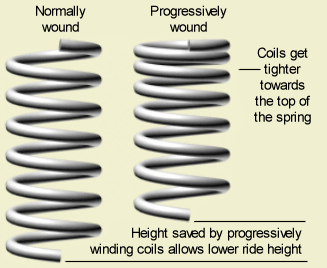Top 5 Things to Know About Coil Springs
Coil springs are a vital part of your car’s makeup. While we’ve recently talked a lot about shock absorbers, today, we’re diving into the small but mighty coil spring. These important parts also absorb shock and preserve the force between two connecting surfaces. That’s why you see them in many of our everyday items—from watches to toys to cars. In vehicles, they absorb the bumps from the road, but that’s not all they’re good for. Below, we’ve broken down five of the most important things you should know about coil springs.
- They can provide an extra boost—both physically and aesthetically.
Since coil springs give your car extra height, they provide less sagging and potential for damage to the underside of your car. They provide more stability and the ability for better handling which increases comfort, especially during adverse road conditions. And coil springs can be tailored to fit your desired effect—if you prefer a lower ride or a more elevated one, coil springs can make a difference.
- There are plenty of options.
Drivers’ preference is important when it comes to selecting coil springs. Lowering, lifting, performance and comfort are options to consider when selecting coil-springs. Three of the most common are helical springs, progressively-wound springs, and linear springs. Helical springs, also known as compression springs, store energy until it’s released at some point and are known to be more predictable. Progressively-wound springs, also known as dual-rate springs, have varying spring rates when compressed but allow for an ideal spring rate in different road conditions. Most of our lowering spring kits for newer Mustangs and Dodge Challengers are progressive-wound springs. These allow for a smoother ride over both small bumps and larger ones like potholes. Linear springs, on the other hand, have a more constant spring rate. We’re big fans of this; in fact, most of the coil springs we produce are linear, cold-wound springs.
- The materials matter.
When choosing coil springs, it’s important to take your location into account. Temperature and chance of corrosion (e.g., the humidity in the air) affects the life and integrity of different coil spring materials. They are commonly made from steel alloys or stainless steel since stainless steel is resistant to corrosion. Silicon is also commonly used in vehicles because of its ability to withstand high levels of heat and impact. Our customized options are made from chrome silicon steel, which increases their life span and durability.
- They decrease wear and tear.
Coil springs absorb a lot—literally. Because they are taking the brunt of the impact from road conditions, they help to protect other aspects of your car like the suspension and tires. They also assist in the distribution of weight which increases maneuverability and provides a smoother ride. It’s worth it to invest in the right ones to maintain the rest of the vehicle’s integrity.
- Coil springs should be replaced over time.
Because of the important role they play, coil springs should be replaced when they show signs of deterioration. As they age, they lose the ability to bounce back as well; this can cause sagging and damage to the low-lying components of the car. In addition, older coil springs can skew tire position and wear them down more quickly as well as cause unpredictable behavior during turns, acceleration, or breaking. Replace them regularly to restore your car’s condition and ensure that your car meets your aesthetic desires.





